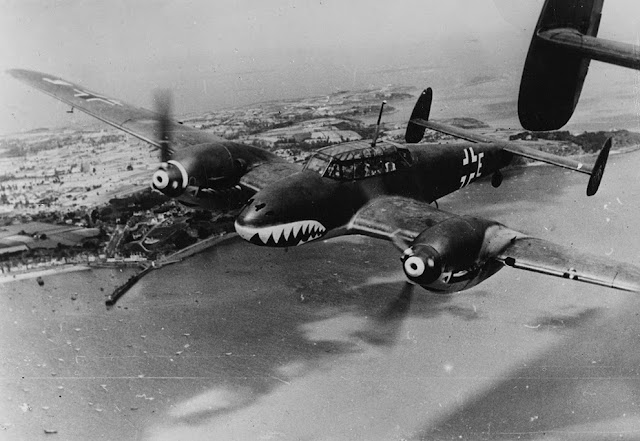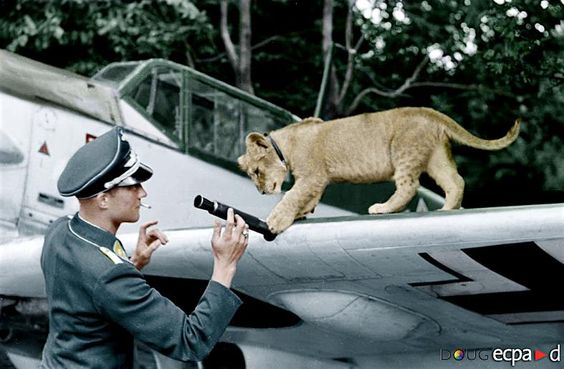Sunday 4 August 1940
Battle of Britain: The weather is clear and with high cloud cover, interspersed with bouts of sunshine. The Luftwaffe, preparing for the Adler Tag operation, is noticeably quiet during the day, performing reconnaissance along the south coast of England.
Some action occurs around 11:00 when a Dornier Do 17 escorted by 10 Bf 109s attacks a convoy off Manston. The RAF takes the obvious bait (though Fighter Command can't know what kinds of planes they are) and intervenes, downing a Bf 109.
At 13:25, the day's major Luftwaffe operation begins when approximately 120 aircraft form up over Calais and attack a convoy off Dover. The Germans lose numerous planes in this attack, including at least half a dozen Bf 110s, a Bf 109, a Dornier Do 17 bomber, and a Dornier Do 215 seaplane. The Bf 110s are proving to be a liability on the Channel front.
During the night, the Luftwaffe sends raids against several targets, including the military base at Cambridgeshire. These raids continued to drop copies of Hitler's 19 July 1940 speech called "The Last Appeal to Reason" all across England. The Luftwaffe loses one Heinkel He 111 on these missions from unknown causes.
A flight of Swordfish of RAF No. 812 Squadron attack oil tanks and barges at Rotterdam, losing one plane. Bomber Commands sends raids against oil installations at Sterkrade in the Ruhr and the airfield at Krefeld.
The RAF doesn't lose any fighters in combat, but they do lose one in a practice exercise when a Spitfire of No. 616 Squadron spins in during a practice dogfight near Kirton. The pilot, 20-year-old J.P. Walsh, perishes.
Egmont Prinz zur Lippe-Weißenfeld, top night fighter pilot distinguished by being of royal blood, joins the first night fighter (Nachtjagdgeschwader 1) wing operating out of Gütersloh, Germany.
 |
| A Ju 87 B Stuka of the 4/StG 77 at Bouchy airfield near Evrecy, France. August 1940. It is being loaded with 500 lb bombs, most likely for shipping attacks. |
U-52 torpedoes and sinks 4586-ton British freighter Gogovale at 03:35. There are 36 survivors and 3 crew perish.
At the same time, U-52 fires and hits 5272-ton British freighter King Alfred. There are 31 survivors, and 8 crew perish.
Later in the morning, Captain Salman presses his luck in daylight and U-52 strikes again. At 09:22, it torpedoes and sinks 7244-ton British freighter Geraldine Mary, which aside from newsprint and pulp also is carrying some passengers. There are 48 survivors, and 3 people perish.
Now that it is daylight, the escorts have some idea from where the attack was launched. U-52 undergoes a vicious depth charge attack by the convoy's destroyer escort. It barely survives, but is badly damaged and limps back to port for major repairs.
U-58 (Oberleutnant zur See Heinrich Schonder) spots a straggler from Convoy SL 40 about 21 miles west of Tory Island. It puts two torpedoes into 4350-ton freighter Pindos at 21: 20. There are 29 survivors and 3 crew perish. The lifeboats make landfall at Downings, County Donegal with the assistance of a local fishing boat.
In the central Atlantic east of Florida, Kriegsmarine raider Widder (Captain Helmuth Ruckteschell) stops and sinks 6114-ton Norwegian tanker Beaulieu after darkness falls. There are 4 crew deaths and 28 survivors. The incident almost sinks the Widder as well because one of its torpedoes becomes a circular runner and almost hits it. The crew is left to fend for itself in the middle of the Atlantic in its lifeboats, which is skirting international law; customarily, German raiders take the crew prisoner. Doing so, however, is not a war crime, as determined by a later tribunal.
Royal Navy trawlers HMS Drummer, Marsona and Oswaldian all hit mines and sink during the day off the English coast. There are 25 deaths total from the sinkings.
The Luftwaffe damages British freighter White Crest off the north coast of the Scottish mainland.
British heavy cruiser HMS Berwick (CA 65) departs Liverpool in thick fog after just undergoing repairs. At 00:34, it collides with another (unknown) ship and sustains more damage, sending it back to the Glasgow repair yard.
The British also have a submarine success. HMS Sealion sinks the Torun, a captured Norwegian freighter, southwest of Stavanger.
A German patrol boat, the 428 ton UJ.175 Perseus, hits a mine north of Ameland, Netherlands, and sinks.
Convoy MT 130 departs from Methil, Convoy FS 242 departs from the Tyne, Convoy OB 193 departs from Liverpool, Convoy HX 63 departs from Halifax.
The RAF bombs the Italian airfield at Bir el Gobi in Libya, engaging in dogfights with the Regia Aeronautica in the process. The Italians, for their part, raid their favorite targets Sidi Barrani and Mersa Matruh.
Malta has a quiet day again, with an air raid alert at 15:15 which appears intended by the Italians to bait a response by the new defending Hurricane fighters. Nothing comes of it, however. Governor Dobbie, meanwhile, creates a new organization called the Malta Volunteer Defence Force designed to combat enemy parachutists. Everyone is issued a helmet and armband; guns are optional and provided by the civilian.
General Sir Archibald Wavell, Commander in Chief of British forces in Egypt, departs Alexandria for London by airplane for consultations. The flight is extremely hazardous, crossing close to or over enemy territory and most definitely within the range of enemy fighters practically the entire way. The plane is attacked twice by the Luftwaffe but not brought down. The first stop is Malta on the morrow.
Battle of the Indian Ocean: Australian heavy cruiser HMAS Canberra departs Simonstown for Freemantle, where it will undergo an overhaul of one of its propeller shafts.
Anglo/Japanese Relations: With the British having arrested some Japanese businessmen in London yesterday, the Japanese suddenly release three of the remaining British citizens it had arrested on espionage charges a week ago.
German Homefront: In an odd policy change that runs against major strains in the German character, the government decides that beer has been degrading the German will to fight. An ersatz, non-alcoholic replacement is sought.
British Homefront: It is the 26th anniversary of the declaration of war against the Kaiser's Germany that began World War I. The day is noted on the BBC but otherwise given little attention.
|
|
Charles Lindbergh, on the other hand, is equally legendary. He also gives a speech in the evening at a rally in Chicago with a somewhat different prescription: isolationism. His speech is not broadcast, though everyone knows his views, and accounts will appear in the morning papers as a rebuttal to Pershing. Lindbergh wants America to look after its own affairs and stay out of the European war, saying "if our own military forces are strong, no foreign nation can invade us and if we do not interfere with their affairs none will desire to."
Public opinion is split on this issue. The Roosevelt administration wants to help Great Britain, but public opinion as evidenced by Gallup polls is heavily against anything that might lead to war. This public debate becomes intertwined with Congressional debate over the draft, and there is strong grassroots opposition - especially among women - to conscription. Thus, Lindbergh's stand is popular and Pershing's less so. However, both have fervent supporters and strong bases of support.
Isolationism-vs.-interventionism also is becoming a major factor in the Presidential race. Republican nominee Wendell Willkie favors somewhat modified isolationism, while the President and now Democratic nominee Franklin Roosevelt is well-known as an interventionist. To the extent that the election becomes a referendum on the issue, Roosevelt may be in trouble, but he is extremely popular for other reasons.
August 1940
August 1, 1940: Two RN Subs Lost
August 2, 1940: Operation Hurry
August 3, 1940: Italians Attack British Somaliland
August 4, 1940: Dueling Legends in the US
August 5, 1940: First Plan for Barbarossa
August 6, 1940: Wipe Out The RAF
August 7, 1940: Burning Oil Plants
August 8, 1940: True Start of Battle of Britain
August 9, 1940: Aufbau Ost
August 10, 1940: Romania Clamps Down On Jews
August 11, 1940: Huge Aerial Losses
August 12, 1940: Attacks on Radar
August 13, 1940: Adler Tag
August 14, 1940: Sir Henry's Mission
August 15, 1940: Luftwaffe's Black Thursday
August 16, 1940: Wolfpack Time
August 17, 1940: Blockade of Britain
August 18, 1940: The Hardest Day
August 19, 1940: Enter The Zero
August 20, 1940: So Much Owed By So Many
August 21, 1940: Anglo Saxon Incident
August 22, 1940: Hellfire Corner
August 23, 1940: Seaplanes Attack
August 24, 1940: Slippery Slope
August 25, 1940: RAF Bombs Berlin
August 26, 1940: Troops Moved for Barbarossa
August 27, 1940: Air Base in Iceland
August 28, 1940: Call Me Meyer
August 29, 1940: Schepke's Big Day
August 30, 1940: RAF's Bad Day
August 31, 1940: Texel Disaster
2020






No comments:
Post a Comment